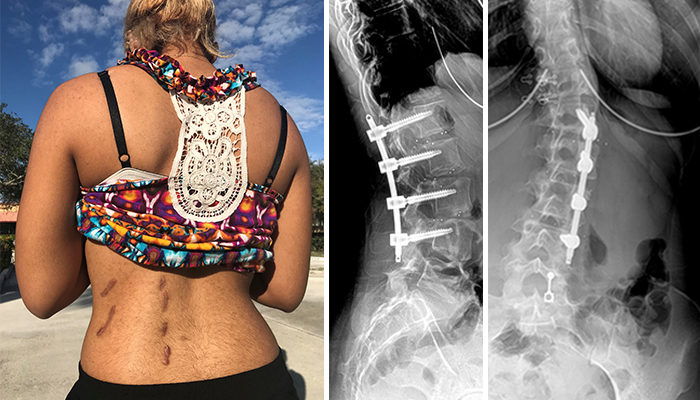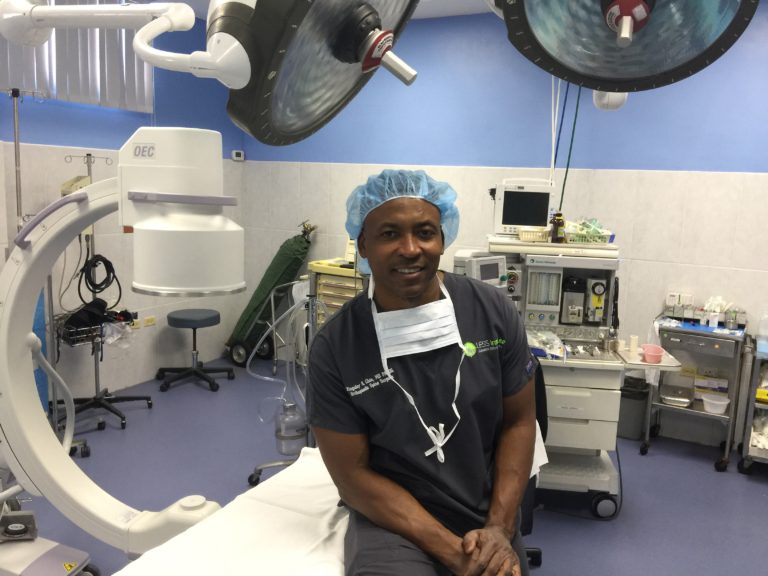Written by Fabio Pencle & Garianne Bowen
Compiled & edited by Esther Rodriguez
Adolescent idiopathic scoliosis (AIS) is the most common form of pediatric scoliosis in individuals between the ages of 10 and 18,1 found in as many as 4 in 100 adolescents.2 By definition, idiopathic scoliosis implies the cause is unknown or not related to a specific syndromic, congenital or neuromuscular condition. Treatment options include conservative management, bracing or operative intervention.
Marketing Intern Garianne Bowen is no stranger to a life with adolescent scoliosis, although she may not have known it at first.
“Looking back, though I had the signs of scoliosis growing up, my family wasn’t aware of the potential for this diagnosis. We all thought nothing could be done of it – and though I tried to accept it, I somehow could not,” she said. Bowen spent years settling for a life that held so much more potential, in the physical and emotional space. In a world where lives are hyper visual with social media exposure, “I always felt uncomfortable in my own body. It sometimes felt like I didn’t know how to walk correctly, and that eyes were always on me. My breasts were two different sizes, my stride wasn’t straight, clothes fit awkwardly and I experienced occasional annoying back pain. My shoulder was damaged by birth and my parents attributed that to me being ‘different,'” said Bowen.
Eventually Bowen’s parents discovered an article on scoliosis – and as they read, realized she fit the mold so entirely. Because of this, they scheduled an X-ray to be read by an orthopedic surgeon, witnessing first hand their daughter’s 40 degree spinal curvature.
A proper adolescent scoliosis evaluation includes X-ray imaging from various angles. Generally speaking, those with curves of 10 to 25 degrees are monitored for surveillance with serial X-rays. This is usually at three, six or 12 month intervals. Those with curves greater than 25 degrees but less than 40 to 45 degrees are candidates for bracing. And those with curves of over 40 to 45 degrees who are skeletally immature are considered operative candidates.3
Bowen’s 40 degree spinal curvature seen through X-ray
During her preliminary orthopedic visit, her doctor at the time being highly encouraged Bowen to undergo a spinal fusion from the neck down, a more major procedure for an adolescent scoliosis case that would limit Bowen’s flexibility and motion. But Bowen was not so on board. She became determined not to undergo surgery, adapting to a life of covering her curvature and accepting pain as the norm.
Three years post scoliosis discovery, Bowen’s mother met Orthopedic Surgeon Dr. Kingsley R. Chin at a conference. Impressed by his profile as a successful Jamaican-born, Harvard-trained spinal surgeon, she brought her daughter to him straightaway to determine a second opinion regarding treatment options. Dr. Chin assured Bowen he would not be completing a full spinal fusion, introducing a Less Exposure Surgery procedure in its place – and clarifying her every concern regarding maintaining motion post-procedure.
Dr. Chin pioneered this LES procedure, a short segment scoliosis surgery with a focus on the apical curve, gearing treatment to the levels above and below – limiting fusion levels.
“As he reassured me, my perceptions of the procedure were altered for the positive,” she said, and after further personal research and consideration, she ultimately trusted Dr. Chin to perform the surgery. “I am so grateful to have gotten to that place,” attests Bowen.
We know it’s vital to prioritize our health, but we must also expose ourselves to our options that lie ahead. Explore your varying avenues of recovery and choose the most appropriate healing method for you.
“I can personally vouch for Dr. Chin as a top orthopedic surgeon, as I begin enjoying my young years to my utmost potential – confident and free of pain.”
And just like that, from curvature to confidence, Bowen leads a life of health, happiness and pain-free motion.
The Less Exposure Surgery Advantage
In advancing Less Exposure Surgery, The LESS Institute aims to reduce operative time, minimize blood loss and decrease instrumentation, while improving overall outcomes. For more on adolescent scoliosis cases with The LESS Institute, see the Jamaica Gleaner article and our post titled 15-Year-Old Jamaican Girl Appreciates Life Changing Scoliosis Surgery in Jamaica by Dr. Kingsley R. Chin.
About Dr. Kingsley R. Chin
Dr. Kingsley R. Chin is a board certified Harvard-trained orthopedic spine surgeon and professor with copious business and information technology exposure. He sees a niche opportunity where medicine, business and info. tech meet – and is uniquely educated at the intersection of these three professions. He has experience as Professor of Clinical Biomedical Sciences & Admissions Committee Member at the Charles E. Schmidt College of Medicine at Florida Atlantic University, Professor of Clinical Orthopedic Surgery at the Herbert Wertheim College of Medicine at Florida International University, Assistant Professor of Orthopaedics at the University of Pennsylvania Medical School, Visiting Spine Surgeon & Professor at the University of the West Indies, Mona, and Adjunct Professor of Clinical Biomedical Studies at the University of Technology, Jamaica.





